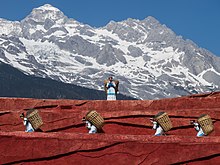Nakhi people

Nashi people carrying baskets
|
|
| Total population | |
|---|---|
| 300,000 | |
| Regions with significant populations | |
|
|
|
| Languages | |
| Nashi | |
| Religion | |
| Dongba, Tibetan Buddhism, Taoism | |
| Related ethnic groups | |
| Tibetans, Qiang, Mosuo |
The Nashi (simplified Chinese: 纳西族; traditional Chinese: 納西族; pinyin: Nàxī zú; endonym: ¹na²khi) are an ethnic group inhabiting the foothills of the Himalayas in the northwestern part of Yunnan Province, as well as the southwestern part of Sichuan Province in China.
The Nashi are thought to have come originally from northwestern China, migrating south toward Tibetan populated regions, and usually inhabiting the most fertile river-side land, driving the other competing tribes farther up the hillsides onto less fertile land. The Nashi, along with Bai and Tibetans, traded over the dangerous overland trading links with Lhasa and India, on the so-called Tea and Horse Caravan routes. They were brought to the attention of the Western world by two men: the American botanist Joseph Rock and the Russian traveller and writer Peter Goullart, both of whom lived in Lijiang and travelled throughout the area during the early 20th century. Peter Goullart's book Forgotten Kingdom describes the life and beliefs of the Nashi and neighbouring peoples, while Joseph Rock's legacy includes diaries, maps, and photographs of the region, many of which were published in National Geographic. The two were friends and left the region together when the Communist troops came in.
The Nashi form one of the 56 ethnic groups officially recognized by the People's Republic of China. The official Chinese government classification includes the Mosuo as part of the Nashi people, although neither ethnicity support this categorization. Although both groups are descendents of the Qiang people, together with the Pumi and Yi, and notwithstanding very striking resemblances between their respective languages, the two groups are now understood to be culturally distinct, the Nakhi more influenced by the very patriarchal Han Chinese culture, the Mosuo more influenced by Tibetan culture and their own matriarchal family practices.
...
Wikipedia
